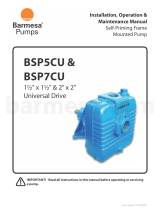
4
4Receiving inspection
Upon receiving the pump, it should
be inspected for damage or
shortages. If damage has occurred,
file a claim immediately with the
company that delivered the pump. If
the manual is removed from the
packaging, do not lose or misplace.
4Storage
Any product that is stored for a
period longer than six (6) months
from the date of purchase should be
bench tested prior to installation. A
bench test consists of, checking the
impeller to assure it is free turning
and a run test to assure the motor
(and switch if provided) operate
properly.
4Controls
Manual models require a separate
approved pump control device or
panel for automatic operation. Be
sure the electrical specification of the
control selected properly match the
electrical specifications of the pump.
4Submergence
The pump should always be
operated in the submerged
condition. The minimum sump liquid
level should never be less than above
the pump’s volute (See Figure 1).
4Discharge Piping
Discharge piping should be as short
as possible and sized no smaller than
the pump discharge. Do not reduce
the discharge pipe size below that
which is provided on the pump.
Both a check valve and a shut-off
valve are recommended for each
pump. The check valve is used to
prevent backflow into the sump. The
shut-off valve is used to manually
stop system low during pump
servicing.
Overload Protection:
Single Phase - The stator in-winding
overload protector used is referred to
as an inherent overheating protector
and operates on the combined effect
of temperature and current. This
means that the overload protector
will trip out and shut the pump off if
the windings become too hot, or the
load current passing through them
becomes too high.
Figure 1
Recommended
Submergence Level
Minimum
Submergence Level
10"
Bottom of Feet
Recommendations and Warnings
4Installation
These pumps are recommended for
use in a sump, basin or lift station.
The sump, basin or lift station shall
be sealed and vented in accordance
with local plumbing codes. This
pump is designed to pump
sewage, effluent or wastewater,
non-explosive and non-corrosive
liquids and shall NOT be installed
in locations classified as hazardous
in accordance with the National
Electrical Code (NEC) ANSI/NFPA
70 or Canadian Electric Code (CEC).
The pump should never be installed
in a trench, ditch, or hole with a dirt
bottom. The legs will sink into the
dirt and the suction will become
plugged.
The installation should be at a
sufficient depth to ensure that all
plumbing is below the frost line. If
this is not feasible, remove the check
valve and size the basin to
accommodate the additional
backflow volume.
Pumps are most commonly installed
in simplex or duplex stations or
basins with a slide rail system
(Barmesa SRC), which allows the
pump(s) to be installed or removed
without requiring personnel to enter
the station, or resting on the basin
floor.
4Liquid Level Controls
The level control(s) should be
mounted on the discharge piping, a
cable rack or float pole. The level
control should have adequate
clearance so it cannot hang up in it’s
swing and that the pump is
completely submerged when the
level control is in the “Off " mode. By
adjusting the cord tether the control
level can be changed. One cycle of
operation should be observed, so
that any potential problems can be
corrected.
4Electrical Connections
Power cable:
The power cable mounted to the
pump must not be modified in any
way except for shortening to a
specific application. Any splice
between the pump and the control
panel must be made in accordance
with the electric codes. It is
recommended that a junction box, if
used, be mounted outside the sump
or be of at a minimum Nema 4
construction if located within the wet
well. DO NOT USE THE POWER
CABLE TO LIFT PUMP.
It is recommended that the level
control float should be set to insure
that the liquid in the sump never
drops below the top of the motor
housing or a minimum level of 10
inches above the basin floor.
Always rely upon a Certified
Electrician for installation.
barmesa.com




























